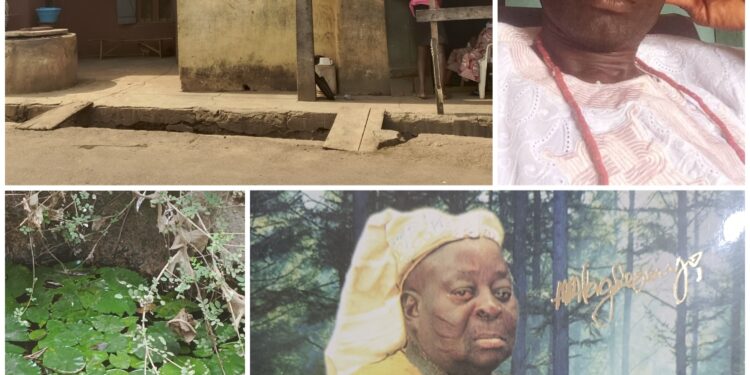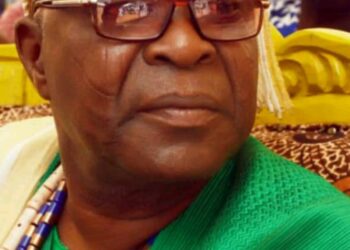Sayo Àlàgbé
stephenalagbe08@gmail.com

Every lineage and the households within it has it’s peculiarities. Some are positively inspiring, some are historically inspiring, some are spiritually inspiring in nature. They are not existing to occupy space in family culture and traditions, they are emblem of identity and solutions to nagging problems. Sadly, modernity and civilisation have wrecked havoc on them rather than the glorification of their significances. There are instances.
Beyond the above introduction lies the importance of self examination and critical consideration of what left to be preserved and what left to be glorified. Thus, this leads this writer to one of the sacred landmark and lineages in Ogbomosholand called Fóyánmu compound; – whose birth was not an accident. It was a design of nature. executed and preserved by nature.
To be candid, as the Yoruba proverb declares, “Ninu igbó nlá la tii rí eye kírèé,” meaning “In a vast jungle, we shall find a rare and mysterious bird.” This timeless saying aptly captures the essence of Ogbomoso, a city rich in history and brimming with hidden treasures waiting to be unearthed. Beyond its reputation as the second-largest city in Oyo State after Ibadan, Ogbomoso is a repository of culture, tradition, art, and mysticism. Even the emergence of Ogbomosho is historically mysterious. Not so?
True to its commitment to unravel hidden stories and forgotten marvels, ScoopChase recently discovered a breathtaking site of great historical and spiritual significance — a mysterious lake tucked away in the heart of Fóyánmu compound: the ancestral home of the legendary Ìjálá bard, philosopher, and poet-king, Chief Ogundare Fóyánmu.
Significantly l, the lake, situated within Taàrá Ward in Ogbomoso North Local Government, is a marvel in its own right. Unlike any other body of water in the city, it has never dried up despite the changing seasons—rain, sunshine, or harmattan. The lake holds generations of stories, secrets, and spiritual potency that have shaped the lives of those who dwell around it and benefitted from its existence.
Beyond reasonable doubts lie the fact that the enigmatic Chief Ogundare Fóyánmu – as legend and mystery personified; added values to the mystical existence of Foyanmu compound. The late Chief Ogundare Fóyánmu was no ordinary man. He was renowned for his deep knowledge of Ìjálá chanting (a traditional Yoruba oral poetry genre), his fame and performances extended beyond the borders of Nigeria. His powerful panegyrics and philosophical lyrics became a treasure trove for scholars of Yoruba Language, African studies, and literatures. His works have been studied in Nigerian universities and cited in countless academic papers. To this day, his voice fills the air-waves of Southwest Nigeria, where radio stations play his songs regularly and within the celebration of traditional and cultural festivals. He was a force to reckon with.
Nevertheless, Chief Fóyánmu was more than a celebrated bard; his entire existence was cloaked in mystery. Born with a defect—one eye and a partially formed leg — he was a prodigious figure with extraordinary traits which made him stand out from birth. Despite not being born into a family of traditional Ìjálá musicians, Fóyánmu mastered the art through dreams and the guidance of mystical beings, particularly elves. His talent was divine, inimitable, and unparalleled until his death. He came with his identity, he shared it with his lineage.
Remarkably, his passing was nothing short of extraordinary. On the day of his burial, seven cars, including a Jeep, failed to start to convey his remains to Òkè-Alapata in Ogbomoso South. It wasn’t until seven hunters carried his body on foot, accompanied by his traditional hunting regalia, that his journey to eternity continued.
Notably too, Chief Ogundare Fóyánmu’s family home, was generically known as: ‘Ile Afìlèmú’; and metamorphosed to be popularly called: “Ile Fóyánmu”, attributed to the late bard legend – who dubbed as an entertainer and his frequent self-eulogies during performances: “Èmi Ogundare omo Fóyánmu,” meaning “I am Ogundare, son of Fóyánmu.” Over time, the name stuck, and people from all walks of life believed that Fóyánmu compound was the original name of his source. This. overshadowed its earlier identity.
Moreover, Fóyánmu’s compound sits on the tributary of Oba River, which flows into Osun River. According to Chief Rotimi Ogundare Fóyánmu, the first son of the bard, this lake has existed for over 300 years without submerging the compound. The lake traces its origins to the Oba River and connects with another tributary known as Abojúupa, which flows through Apàkèrè and rejoins the main Oba River at Ìlújú, another part of Ogbomoso. Only few historians are aware of this.
Furthermore, Chief Rotimi revealed that the lake holds powerful healing properties. For generations, it had been a source of spiritual and physical healing for the family and the surrounding community. Every year, the family makes necessary sacrifices to the lake, offering kolanuts, salt, palm oil, pigeons, and doves. This ritual ensures the continued potency of the lake and the protection of the family.
Insightful, the lake’s mystical power is its identity and symbolism of the bequeathed mystery from nature to lineage of Foyanmu. As a result , it is imperative to reiterate that the mystical lake within Fóyánmu compound is not like other anonymous and ordinary body of water. Its surface is covered with lush water lettuce and lilies believed to possess curative powers. Chief Rotimi established that any child from Fóyánmu’s family, who bathes in the lake’s water is instantly healed of any ailment. Strangers who have unwavering faith in its healing power have also reported miraculous recoveries. As Francis Bacon once said: seeing is believing.
However, the lake’s spiritual rules are strictly adhere to, towards sustainable and manifestation of expected outcomes. One of the cogent rules is that: dogs are strictly forbidden from approaching or drinking from the water. As stated by Chief Rotimi, any dog that dares to drink from the lake dies instantly. This prohibition is deeply respected, much like the tradition among the children of Olúgbón, who are forbidden from eating dog meat.
Having read little about what the lake has to offer, there is no better time than now to champion a noble course of action for the preservation and recognition of such rare endowment of nature. To buttress the foregoing, Chief Rotimi Ogundare Fóyánmu has passionately called on the Oyo State Government to explore and develop the lake as a tourist site. He urged the government to showcase Ile Fóyánmu to the world as a cultural and historical monument. He also reminded Governor Seyi Makinde of his earlier promise to honor Chief Ogundare Fóyánmu by turning the family compound into a museum and naming a school in Ogbomoso North Local Government after him.
In his words, “This lake is not just a family treasure; it is a gift to the people of Oyo State and Nigeria at large. It deserves to be preserved and celebrated.”
BEFORE the curtain is drawn on this noble topic, it is no longer news that a hidden treasure awaits the efforts and investment to be made in preserving this art of nature.
Ogbomoso’s Fóyánmu Compound or household is not just among the lexicon of households; it has history, identity, ambassadors and is more than just a family compound: it is a living mystery, culture, and possesses spiritual significances. The lake stands as a evidence to the Ogbomosho’s rich heritage, and serves as a beacon of hope for those seeking healing and connection with the past. If developed and promoted, this sacred site could become a major tourist attraction, drawing visitors from far and wide, to witness the wonders of Ogbomoso’s mystical legacy.
METAPHORICALLY, the lake is one of the last of the strong ones. Others are yet to be given attention they deserve; or like the extinction of the dinosaurs, they are living on borrowed time. There is no better time than now to take critical steps. The onus rests heavily on Oyo State Government to do the needful. A stitch in time, many times, saves more than nine!
You can get every of our news as soon as they drop on WhatsApp ...To get all news updates, Join our WhatsApp Group (Click Here)







